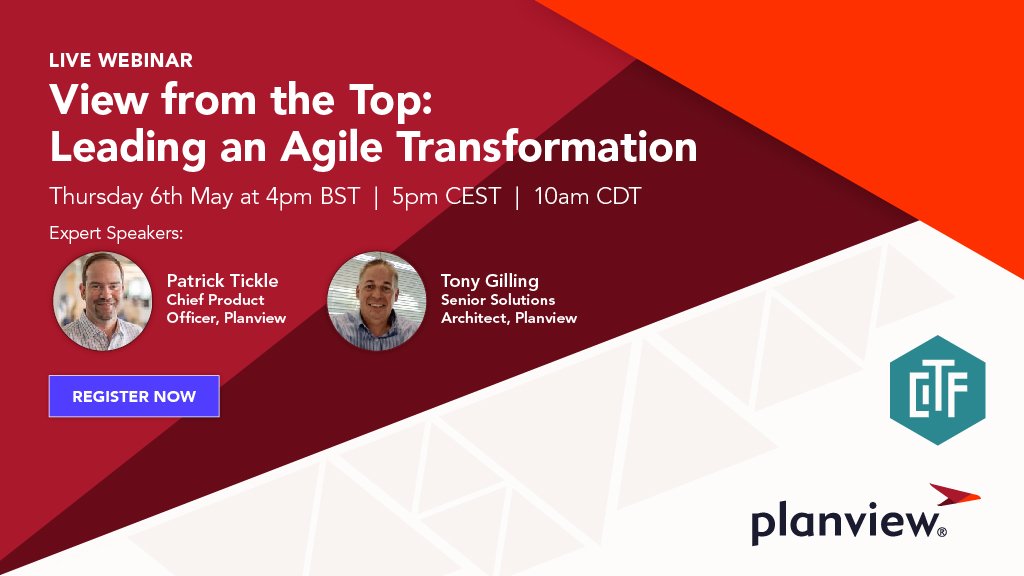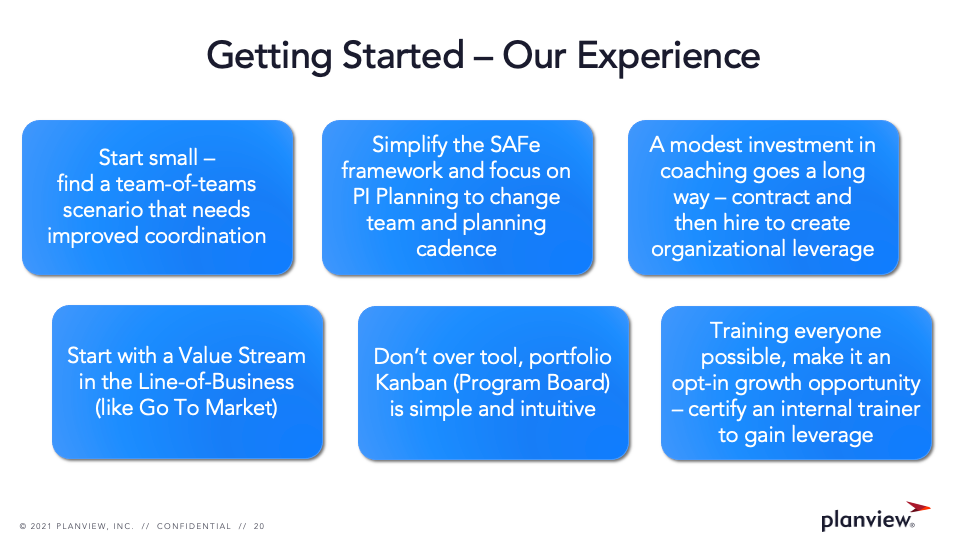
Most organizations are on a transformation journey of some kind, including Planview. It can be challenging to expand Agile practices beyond IT and development teams. Planview is committed to helping our customers with this transition and to that end, Chief Product Officer Patrick Tickle and I recently presented a webinar on “Leading an Agile Transformation.”
Hosted by CITF, the UK’s leading membership organization for technology professionals, the webinar includes our insights and recommendations on extending Agile practices. These are based not just on our professional expertise, but also our experience undergoing an Agile transformation of our own at Planview.
Here I’ll summarize a few of our thoughts and tips through the vehicle of several great questions asked by the attendees. The webinar is on-demand, so I encourage you to watch it for all the details.
First, why scale Agile in the first place?
Why Make the Transformation Journey?
During the webinar, Patrick remarked that nearly every organization he speaks with wants to drive agility across the business. Executive teams have seen how Agile practices can help organizations gain speed, pivot quickly and effectively when needed, and deliver high-quality outcomes on strategy.
The need to move faster is caused by several converging factors: Companies are dealing with a frenetic pace of business, punctuated by seemingly constant disruptions, competitive threats, shifting customer demands, and more.
Another factor is the transition from projects to products, where the focus is on delivering customer value incrementally, more quickly, and at a higher quality. The continuing impacts from the pandemic, such as working from home, have also accelerated the need to operate differently. At the same time, our traditional planning processes cannot keep up or sustain us anymore: The annual plan is most on-strategy the day you finish it. Patrick has dubbed this phenomenon “strategy atrophy.” Every quarter that goes by, the plan becomes less relevant.

It’s difficult to react swiftly to change when your plans and budgets are set in stone. Then the past year threw everyone for a loop. We wonder if many enterprises even did annual planning for 2021: How many organizations are still running off the plan they created in 2019?
This is why the making the transformation journey toward agility is so critical.
How to Start Your Own Transformation Journey – Questions and Answers from the Webinar
Where do you begin? What needs to change? At a high level, it’s important to start planning more often as a company. A continuous planning cadence – quarterly, monthly, or even weekly – enables organizations to be ready to move fast when change occurs, or new opportunities appear on the horizon.
Increased agility stems from more frequent planning. Read on to review some answers to questions asked during the webinar along with a few of our other recommendations.
Q: When you start scaling Agile, some of its building blocks – transparency, collaboration, continuous improvement become much more difficult. How do you maintain a shared vision and how do you maintain that when scaling?

A: One thing that worked well for us is to start small outside of IT. We began with our go-to-market teams and decided to use practices from the Scaled Agile Framework (SAFe), which is becoming the standard across industries. SAFe has a mechanism for continuous planning called Program Increment or PI planning.
Every 10 weeks, we do PI planning for the next quarter. PI planning creates more synergy and transparency on where we’re going and why we are doing things. We gain this visibility using our own enterprise Kanban software, Planview AgilePlaceTM.
When you combine Agile practices with in-flight visibility into work, resources, financials, status, and more, the process accelerates on-strategy delivery of business outcomes. Creating a portfolio-level Kanban board gives you this ability by visualizing the epics of work to be delivered by the teams. Patrick said this is the future of portfolio management and the linchpin of a transformation journey.
Q: How do you structure big Program Increment planning meetings – virtually?
A: It’s important to get some coaching on this, especially since we operate on Zoom and across different time zones. We originally hired a contractor Agile coach who eventually became a full-time in-house Agile coach. He not only owns the process for PI planning but also the logistics, tooling, and agenda.
His leadership has made our process seamless. Every time we go through PI planning now, more light bulbs come on. People are becoming more comfortable with the process and seeing the benefit.
We started this process before the pandemic, so we had the benefit of doing our first PI planning sessions in person. Shifting to Zoom was a challenge, but our coach has helped greatly. We also plan break-out meetings around local time zones, so no one has to be on Zoom at odd hours.
Q: I find SAFe’s structure a bit over-prescriptive if I’m honest, so we’ve struggled to translate it to our circumstance. I’m wondering if people have experiences of that.
A: To quote British statistician George E. P. Box, “All frameworks are wrong, but some are useful.” There’s nothing wrong with picking only certain elements of SAFe to implement in your organization, and there’s many other agile frameworks to learn from as well. The main piece we are using from SAFe is the PI planning, along with a few Agile ceremony practices and teamwork delivery principles, and that has accelerated our transformation journey dramatically.
Q: Where is the most common place that organizations fail in this transformation? What considerations should we watch out for?
There are several pitfalls to avoid on your transformation journey. It’s crucial to shift mindsets and follow Agile practices – not just follow the PI planning process and rituals.
It can be tempting for PMOs to stick with traditional PPM approaches that elevate command and control above all else. However, not adapting to and supporting the different ways teams work today will limit any agility you are trying to achieve. PMOs must operate in a hybrid environment and empower teams across a range of different work methodologies such as traditional projects, hybrid or iterative, Lean-Agile, and collaborative.
In that same vein, your retrospectives or post-mortems should result in action. The process is tainted when ideas for improvement are ignored. In addition, falling back on metrics such as “on time” and “on budget” defeats the purpose of Agile.
Cultivate Business Agility at Scale
Start your journey with us. Patrick and I provide far more details in the webinar, including how we organized Planview for Agile planning and delivery, the role of the PMO in scaling Agile, and the evolution to lean portfolio management. Bonus: You get to see us on video!
Watch the full webinar here:





